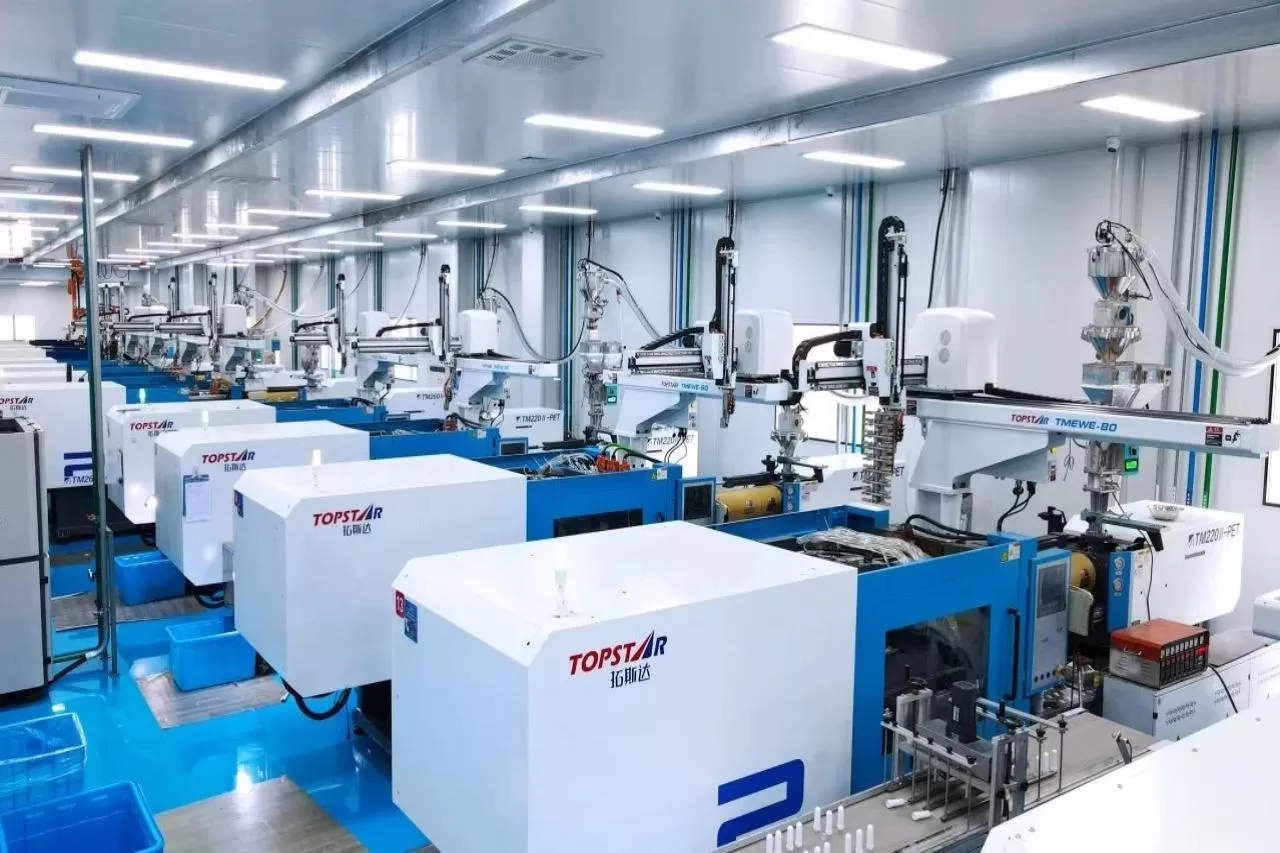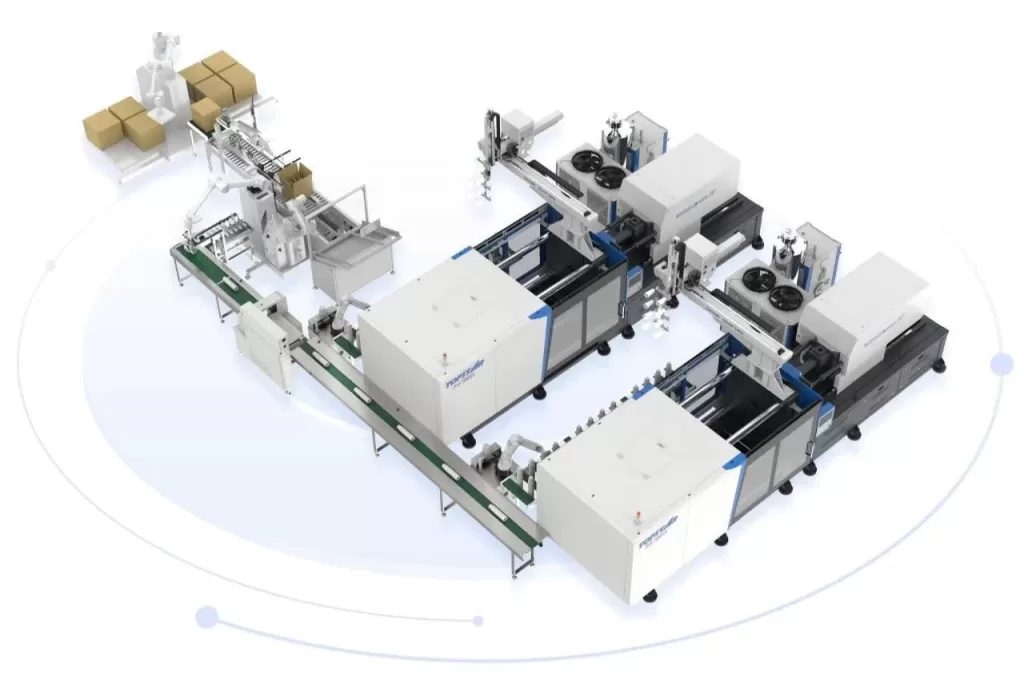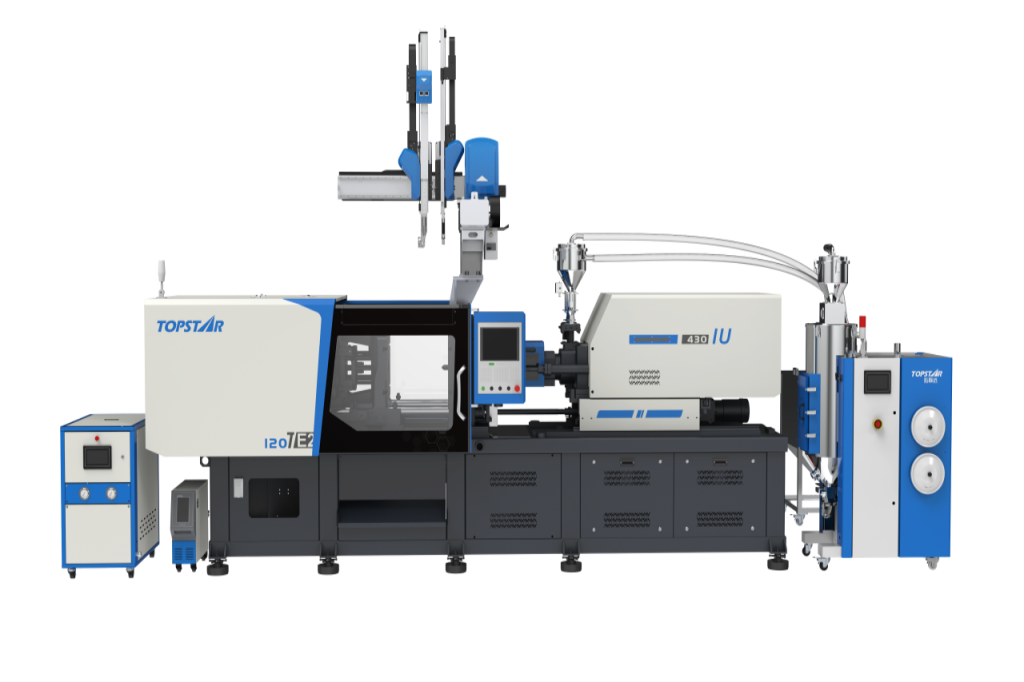How to achieve greater flexibility in plastic molding production?
2025/08/04 By Topstar

In plastic molding, production flexibility can lead to higher production efficiency and enable the meeting of a broader range of customer needs. Traditional plastic molding production environments are rigid, with independent machines and systems operating independently of one another. Each piece of equipment requires a unique configuration before it can be connected, resulting in a fragmented and inefficient production environment. This lack of flexibility hinders the overall performance of the production System. To enhance flexibility, we provide customers with comprehensive solutions that leverage open software control and advanced hardware technology to improve production flexibility. By addressing the core aspects of plastic molding, including material feeding, molding, and part removal automation, and implementing modularization throughout the entire factory, we enable customers to optimize their injection molding processes efficiently. Furthermore, our proprietary control System enables seamless communication between injection molding machines, auxiliary equipment, and automation components, forming a flexible, integrated production System.
Automation is key to flexibility in plastic molding.
The transition from manual to automated plastic injection molding machines has significantly improved production efficiency and flexibility. Automated systems now manage tasks such as loading raw materials, adjusting machine parameters, and monitoring quality. This automation ensures that every stage of the production process is synchronized, reduces human error, and enables real-time adjustments to be made. In plastic molding, material feeding automation ensures that the correct quantity and quality of raw materials are supplied without manual intervention. Molding automation enables the rapid adjustment of molding cycles to accommodate varying product specifications. Furthermore, automated removal systems enhance overall production speed and ensure the precise handling of molded parts, thereby minimizing defects. The flexibility offered by these automated systems enables manufacturers to switch between various products without significant downtime or additional setup, making the overall production process more adaptable to changing production demands.
Increasing Factory Flexibility Through Modularity
Another key to increasing flexibility in plastic molding production is modularity. Plastic injection molding machines are often part of larger systems that incorporate auxiliary equipment such as cooling systems and injection molding robots for part removal. Traditionally, companies built these systems as independent entities, each requiring its own configuration and control system. However, modular design enables each component to work seamlessly with the others. Modularity enables easy upgrades or modifications based on specific production needs, allowing for flexible production planning and management. For example, a company may need to increase production capacity during peak season to meet high demand for a particular product. With a modular approach, they can add more machines or integrate additional automation systems. Furthermore, modularity shortens maintenance cycles, as you can replace or upgrade components without affecting the rest of the production line, ultimately reducing downtime.

Bridging the gaps between equipment with intelligent controls
Integrating intelligent control systems into plastic molding equipment is another major factor in increasing flexibility. Topstar uses proprietary control systems that enable seamless communication between plastic injection molding machines, auxiliary equipment, and automation components, a game-changing technology. These control systems enable real-time data sharing, remote monitoring, and precise management of all equipment parameters. Through our proprietary systems, customers can ensure that every machine on the production line is operating at optimal efficiency without manual intervention. Intelligent control systems also enhance flexibility by allowing operators to adjust settings according to different products or production schedules quickly. Whether adjusting injection speed, temperature, or cooling cycles, these systems enable operators to make quick and precise changes without manually reconfiguring the machine, thereby creating an integrated injection molding process.

Enabling Rapid Adjustments in Plastic Molding Through Real-Time Monitoring
To achieve greater flexibility in plastic molding, real-time monitoring is essential throughout the entire injection molding System. Controlled by our proprietary systems, the entire production process and equipment performance can be tracked in real time through the control interface on the plastic injection molding machine. This enables the quick identification of issues, such as temperature fluctuations, pressure fluctuations, or System failures. By receiving real-time feedback, manufacturers can quickly make adjustments to correct any issues, ensuring smooth and uninterrupted production. Furthermore, real-time monitoring can help optimize cycle times by providing valuable insights into areas for process improvement. If the System detects a machine operating inefficiently, operators can adjust settings or schedule maintenance to address the problem before it becomes a serious issue. This proactive monitoring approach enhances production System flexibility, ensuring that plastic molding operations can operate at peak efficiency.
Bringing Greater Flexibility to Injection Molding Production
We are incorporating automation, modularity, intelligent control systems, and real-time monitoring into injection molding to achieve greater flexibility in production. By utilizing plastic injection molding machines equipped with our proprietary control systems and auxiliary equipment, we enable manufacturers to adapt to changing demands, reduce downtime, and improve overall efficiency, resulting in greater flexibility and scalability.
TRENDING POSTS
- TOPSTAR Global Open Day 2025: Humanoid Robot Debuts, Pioneering a New Decade of Intelligent Manufacturing 2025/08/04
- Topstar Showcases TE II Electric Injection Molding Machines at InterPlas Thailand 2025 2025/08/04
- Topstar Expands Its Ecosystem Partnerships to Drive Smart Manufacturing Innovation 2025/08/04
- What factors can cause delays in the injection molding process of plastic molding machine? 2025/08/04
HOT TOPIC
- .ervo motor-driven linear robots
- •
- 1.0 guangdong topstar technology co. ltd
- 1.0 topstar china
- 1.0 topstar robot
- 11
- 160℃ mold temperature controller
- 170 ton injection molding machine
- 2
- 21
- 220-ton injection molding machine
- 23
- 260 ton injection molding machine
- 3 axis robot
- 3 axis robots
- 3 in 1 Compact Dehumidifying Dryer
- 3-axis robot
- 3-axis robots
- 39
- 41
- 460T injection molding machine
- 5-axis CNC machine
- 62
- 90 ton injection molding machine
- accuracy
- Air Chillers
- all electric injection molding machine
- all electric injection molding machines
- all-electric injection molding machine
- All-electric injection molding machines
- and overall production quality. Therefore
- AP-RubberPlas
- automated injection molding machine
- Automation changed engineering
- automation of injection molding robots
- automotive parts injection molding
- auxiliary machine
- Bench Injection Molding Machine
- Cabinet dryer manufacturers
- Cabinet dryers
- chiller
- CNC Drilling Machine
- CNC Drilling Machines
- cnc engraving machine manufacturer
- cnc laser cutting machine manufacturer
- CNC machine
- CNC Machine Center
- CNC Machine for Sale
- CNC Machine Manufacturing
- CNC Machine Tool
- CNC machine tool product
- CNC Machining Center
- CNC wood carving machine
- Cooling system
- Cross-Walking Single Axis Servo Cylinder Robot
- Cross-Walking Single-Axis Servo Cylinder Robot
- Cross-Walking Three-Axis/Five-Axis Servo Driven Robot
- cross-walking three-axis/five-axis servo-driven robot
- Dehumidifier Dryer
- Dehumidifying Dryer
- delta parallel robot
- Desktop Injection Molding Machine
- Desktop injection molding machines
- Desktop Molding Machine
- desktop plastic injection machine
- Desktop Plastic Injection Molding Machine
- Digital Transformation
- direct clamp injection molding machine
- Direct clamp injection molding machines
- Dosing & mixing system
- Drilling Centers
- Drying and dehumidification system
- drying and dehumidifying equipment
- Drying and Dehumidifying System
- drying system
- effective and efficient. Cabinet dryers are also used in other industries where large quantities of material need to be dried
- efficient injection molding machine
- elbow hydraulic injection molding machines
- electric injection molding machine
- electric injection molding machines
- energy-efficient injection molding robot
- energy-efficient water chiller
- energy-efficient water chillers
- energy-saving injection molding machine
- etc. Among injection molding robots
- exhibition
- features of CNC machine
- Feeding And Conveying System
- Five Axis Machine Center
- Flexible Production Line
- Fully automatic injection molding machine
- Gathering Topstar
- giant injection molding machine
- GMU-600 5-Axis Machining Center
- Granulating & Recycling System
- Heavy duty injection molding machine
- High-precision electric molding machines
- high-precision plastic molding machines
- high-speed all electric injection molding machine
- high-speed electric injection molding machine
- High-Speed Packaging Injection Molding
- Honeycomb rotor dehumidifier
- horizontal injection molding machine
- Horizontal Injection Molding Machines
- Horizontal Injection Moulding Machine
- Horizontal Mixer manufacturer
- How The CNC Machine Works
- hybrid injection molding machine
- hydraulic injection molding machine
- Hydraulic Injection Molding Machines
- in this article
- Industrial AI
- Industrial Automation
- Industrial robot
- Industrial Robot Chinese brand
- industrial robot parts
- industrial robot supplier
- Industrial robots
- Industry Chain
- Injection Manipulator
- injection manipulator robot
- injection mold machines
- Injection molding
- Injection molding automation
- Injection Molding Automation Solution
- injection molding dryer
- Injection molding equipment
- injection molding hopper dryer
- Injection molding machine
- injection molding machine brand
- Injection Molding Machine Factory
- Injection Molding Machine Manufacture
- Injection molding machine manufacturer
- injection molding machine manufacturers
- Injection molding machine procurement
- injection molding machine robotic arm
- injection molding machine with a robot
- Injection molding machines
- injection molding material dehumidifying
- injection molding plant
- injection molding process
- Injection Molding Robot
- injection molding robot arm
- Injection molding robot automation
- Injection molding robotic arm
- injection molding robots
- Injection moulding machine
- injection moulding machines
- Injection Moulding Robots
- Injection Robot
- Injection robot arm
- Injection robot manufacturer
- Injection robot wholesale
- injection robots
- Intelligent Factory
- intelligent injection molding machines
- Intelligent Manufacturing
- intelligent mold temperature
- intelligent mold temperature controller
- Intelligent mould temperature controller
- InterPlas Thailand 2025
- Introducing Injection Robot
- It is the best choice for drying large quantities of material at once. Cabinetmakers use these machines because they are fast
- Large flow water type mold temperature controller
- large injection molding machine
- large injection molding machines
- Learn what industrial automation and robotics is
- linear robot
- linear robots
- low speed sound-proof granulator
- machine plastic molding
- make sure to add some! Improvements (2) Keyphrase in introduction: Your keyphrase or its synonyms appear in the first paragraph of the copy
- manipulator machine
- manufacturing
- Manufacturing Innovation
- medical grade injection molding machines
- Medical Injection Molding
- medical injection molding machine
- medical injection molding machines
- micro injection molding machine
- middle speed granulator
- Mini CNC machine manufacturers.
- mobile cover making machine
- Mold Temperature Control System
- mold temperature controller
- mold temperature controllers
- molding machine
- molding material Dehumidifying System
- mould temperature control system
- mould temperature controller
- mould temperature controllers
- New electric injection molding machine
- nitrogen dryer manufacturer
- nitrogen dryer system manufacturer
- Oil type mold temperature controller
- Oil type mold temperature controllers
- open day
- optical component injection molding
- Outbound links: No outbound links appear in this page. Add some! Images: No images appear on this page. Add some! Internal links: No internal links appear in this page
- packaging injection molding
- Packaging Solutions
- PET Preform injection molding
- phone case maker machine
- phone case making machine
- phone cover making machine
- PID Control Mold Temperature Controller
- plastic bottle making machine
- plastic bottle manufacturing
- plastic bucket making machine
- plastic bucket manufacturing
- Plastic chair making machine
- plastic forming equipment
- plastic hopper dryer
- plastic injection machine
- plastic injection machines
- plastic injection molding
- Plastic injection molding equipment
- Plastic injection molding machine
- Plastic Injection Molding Machines
- plastic injection moulding machine
- plastic injection moulding machines
- plastic injection robot
- plastic molding
- Plastic Molding Industry
- Plastic Molding machine
- plastic molding machine 1
- Plastic Molding Machines
- plastic molding press
- plastic moulding machine
- plastic phone case making machine
- plastic-molding machine
- powerful granulator
- Powerful Type Sound-Proof Granulator
- precision injection molding
- precision injection molding machines
- production of plastic seats
- pure water mould temperature controller
- Robot injection molding
- robot injection molding machine
- robot manufacturing companies
- Robotic arm for injection molding machine
- robotic injection molding machines
- robotics in injection molding
- SCARA robot
- SCARA robots
- Service-oriented manufacturing
- Servo Cylinder Robot
- servo driven robot
- Servo Driven Robots
- servo injection molding machine
- servo injection robots
- servo motor-driven linear robots
- servo-driven 3-axis robot
- Servo-driven injection molding machine
- Servo-Driven Robot
- Setup of injection machine
- Silicone Injection Molding Machine
- six-axis industrial robot
- Smart Manufacturing
- Stainless Hopper Dryer
- Stainless Hopper Dryers
- star club
- swing arm robot
- take-out robot
- take-out robots
- Thailand 4.0
- the choice between servo-driven robots and hydraulic robots will have a certain impact on efficiency
- the most popular injection molding machine
- the type of injection molding robot
- TIC2000 Control System
- TMII injection molding machine
- toggle clamp injection molding machine
- Toggle Hydraulic Injection Molding Machines
- toggle injection molding machine
- Top 10 brands of injection robots
- Topstar
- Topstar Electric Injection Molding Machine InterPlas Thailand 2025 Smart Manufacturing Thailand 4.0
- Topstar Engineering
- Topstar Industrial Robots
- Topstar injection molding intelligent
- Topstar Scara Robots
- Useful Injection molding machine
- Vertical machining centers
- volumetric type blender
- water chiller
- water chillers
- water distributor
- water type mold temperature controller
- Water Type MoldTemperature Controller
- Water-Type Mould Temperature Controllers
- We often face choices when performing injection molding. We will choose the type of injection molding machine
- wholesale of injection molding machines
- x carve CNC
- 热门查询 点击次数 展示 排名 topstar
